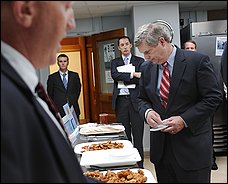
Chicken fajita strips, sliced ham and canned green beans: That's what's for lunch one day next week for some lawmakers and congressional staffers, courtesy of the U.S. Department of Agriculture. The menu offers the same products, known as commodity foods, that the agency provides every day to public schools across the nation.
The goal of next week's tasting is to show lawmakers the improvements the department has made in the nutritional quality -- and taste -- of the $1.2 billion in school commodity foods and to win support to fund further improvements. With one-third of American children overweight or obese, the USDA has been working to cut salt and fat and provide more fruits and vegetables.
"These guys are moving in the right direction," said Tony Geraci, food service director for Baltimore City public schools and a pioneer for healthful foods in schools. "Is it fixed? Hell, no. But at least now we're having conversations about this. Before, it was straight-up stonewalling."
The tasting is also an attempt to rehabilitate the reputation of the commodity foods program, which provides 15 to 20 percent of the food served in U.S. school cafeterias. Officially called USDA Foods, the program has long been perceived as a conflict of interest in the department's mission: to support American farmers and ranchers while overseeing nutrition programs for low-income families and schoolchildren.
Is the program a way to distribute meats, cheeses and other commodities that couldn't find a buyer on the open market? Or is the department really making choices based on public health?
Improving the quality of food provided free to schools is important at a time when school budgets are being squeezed. President Obama has proposed an additional $1 billion for child nutrition programs, including school lunch, in his 2010 budget.
But in the face of a projected federal deficit of $1.3 trillion , even the strongest supporters of school-lunch reform say that Congress is unlikely to approve a substantial funding increase when it takes up the issue next year.
To prepare for the Capitol Hill debut next week, the USDA offered samples to Secretary Tom Vilsack, who tried more than a dozen products, including canned green beans, apple slices and hamburger patties.
On paper, anyway, the green beans looked good. They are formulated to meet USDA specifications and have 64 percent less sodium than commercially available canned beans. For the 2010 school year, the agency has mandated that canned vegetables have no more than 140 milligrams of sodium per serving, 71 percent fewer than in the Food and Drug Administration's "healthy" standard.
The hamburger patties, developed for a pilot program last year to help fight childhood obesity, were 95 percent lean. The most similar commercial beef patty available is 92 percent lean.
The USDA offers more than 180 fresh and processed foods to schools, up from 54 in 1981. The products are provided to schools free, based on the number of students eligible for government assistance. Schools buy the rest of their ingredients from commercial suppliers.
School food directors say the quality of available commodities is excellent -- if schools choose wisely. The USDA offers high-quality dried fruits, nuts, brown rice, legumes and unprocessed meat, among other things.
Last month, the USDA announced that as part of the bonus commodity program, which is part of the commodity foods program and allows the agency to buy surplus food to help support prices for farmers, it would make available $33 million worth of apples, tart cherries and dried plums to schools and other programs. Some of the cherries will be processed into cherry-apple juice, with no artificial colors, flavors or sweeteners, for schools.
At least one challenge remains: persuading schools to embrace the more healthful options. Many schools lack kitchens and are at most capable of reheating prepared items. And many school food service directors do not have nutrition or culinary training.
They also know that they can sell more trays of greasy pizza and french fries to students than fruits and vegetables, a tactic that helps keep tight budgets in line. As food service director Geraci said: "If you have 20,000 lunch ladies that just want to open up a box of chicken nuggets, they're going to keep making them."
To encourage more healthful choices, the USDA is awaiting help from Congress when it takes up the Child Nutrition and WIC Reauthorization Act next year. As part of the legislation, lawmakers are considering a measure that would allow the department to set strict standards for all food sold in schools, including vending machine fare. They are also considering how much new money to allocate to the $12 billion annual program.
Vilsack said he hopes Congress will make more money available.
"The nutritional value of these foods is going to be a little bit more expensive," said Vilsack, who said that he expects costs will rise as more students are granted access to free or reduced-price meals. "We've been making progress on the food safety side and on the nutrition side. But to take the next steps, it's going to require more resources."



Reader Comments
to our Newsletter